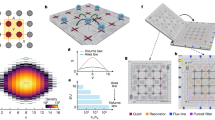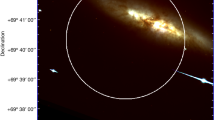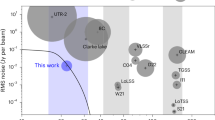Abstract
Ultralight axion-like particles are well-motivated dark matter candidates, naturally emerging from theories of physics at ultrahigh energies. Here we report the results of a direct search for electromagnetic interactions of axion-like dark matter in the mass range that spans three decades from 12 peV to 12 neV. The detection scheme is based on a modification of Maxwell’s equations in the presence of axion-like dark matter that mixes with a static magnetic field to produce an oscillating magnetic field. The experiment makes use of toroidal magnets with ferromagnetic powder cores made of an iron–nickel alloy, which enhance the static magnetic field by a factor of 24. Using superconducting quantum interference devices, we achieve magnetic sensitivity of 150 \(\mathrm{aT}\, {\mathrm{Hz}}^{-1/2}\), which is at the level of the most sensitive magnetic field measurements demonstrated with any broadband sensor. We recorded 41 h of data and improved the best limits on the magnitude of electromagnetic coupling constant for axion-like dark matter over a part of our mass range, at 20 peV reaching 4.0 × 10−11 GeV−1 (95% confidence level). Our measurements begin to explore the coupling strengths and masses of axion-like particles, where their mixing with photons could explain the anomalous transparency of the Universe to TeV γ-rays.
This is a preview of subscription content, access via your institution
Access options
Access Nature and 54 other Nature Portfolio journals
Get Nature+, our best-value online-access subscription
$29.99 / 30 days
cancel any time
Subscribe to this journal
Receive 12 print issues and online access
$209.00 per year
only $17.42 per issue
Buy this article
- Purchase on Springer Link
- Instant access to full article PDF
Prices may be subject to local taxes which are calculated during checkout




Similar content being viewed by others
Data availability
Source data are provided with this paper. All other data that support the plots in this paper and other findings of this study are available from the corresponding author upon reasonable request.
Code availability
The code that supports the plots in this paper is available from the corresponding author upon reasonable request.
References
Spergel, D. N. The dark side of cosmology: dark matter and dark energy. Science 347, 1100–1102 (2015).
Tanabashi, M. et al. Review of particle physics. Phys. Rev. D 98, 030001 (2018).
Liu, J., Chen, X. & Ji, X. Current status of direct dark matter detection experiments. Nat. Phys. 13, 212–216 (2017).
Rajendran, S., Zobrist, N., Sushkov, A. O., Walsworth, R. & Lukin, M. A method for directional detection of dark matter using spectroscopy of crystal defects. Phys. Rev. D 96, 035009 (2017).
Preskill, J., Wise, M. B. & Wilczek, F. Cosmology of the invisible axion. Phys. Lett. B 120, 127–132 (1983).
Abbott, L. F. & Sikivie, P. A cosmological bound on the invisible axion. Phys. Lett. B 120, 133–136 (1983).
Dine, M. & Fischler, W. The not-so-harmless axion. Phys. Lett. B 120, 137–141 (1983).
Arias, P. et al. WISPy cold dark matter. J. Cosmol. Astropart. Phys. 1206, 013 (2012).
DeMille, D., Doyle, J. M. & Sushkov, A. O. Probing the frontiers of particle physics with tabletop-scale experiments. Science 357, 990–994 (2017).
Irastorza, I. G. & Redondo, J. New experimental approaches in the search for axion-like particles. Prog. Part. Nucl. Phys. 102, 89–159 (2018).
Svrcek, P. & Witten, E. Axions in string theory. J. High Energy Phys. 0606, 051 (2006).
Payez, A. et al. Revisiting the SN1987A gamma-ray limit on ultralight axion-like particles. J. Cosmol. Astropart. Phys. 1502, 006 (2015).
Chang, J. H., Essig, R. & McDermott, S. D. Supernova 1987A constraints on sub-GeV dark sectors, millicharged particles, the QCD axion, and an axion-like particle. J. High Energy Phys. 1809, 051 (2018).
Matsuura, S. et al. New spectral evidence of an unaccounted component of the near-infrared extragalactic background light from the CIBER. Astrophys. J. 839, 7 (2017).
Kohri, K. & Kodama, H. Axion-like particles and recent observations of the cosmic infrared background radiation. Phys. Rev. D 96, 051701 (2017).
Graham, P. W. & Rajendran, S. New observables for direct detection of axion dark matter. Phys. Rev. D 88, 035023 (2013).
Budker, D., Graham, P. W., Ledbetter, M., Rajendran, S. & Sushkov, A. O. Proposal for a Cosmic Axion Spin Precession Experiment (CASPEr). Phys. Rev. X 4, 021030 (2014).
Arvanitaki, A. & Geraci, A. A. Resonantly detecting axion-mediated forces with nuclear magnetic resonance. Phys. Rev. Lett. 113, 161801 (2014).
Crescini, N. et al. Axion search with a quantum-limited ferromagnetic haloscope. Phys. Rev. Lett. 124, 171801 (2020).
Battesti, R. et al. High magnetic fields for fundamental physics. Phys. Rep. 765–766, 1–39 (2018).
Ehret, K. et al. New ALPS results on hidden-sector lightweights. Phys. Lett. B 689, 149–155 (2010).
Anastassopoulos, V. et al. New CAST limit on the axion–photon interaction. Nat. Phys. 13, 584–590 (2017).
Graham, P. W., Irastorza, I. G., Lamoreaux, S. K., Lindner, A. & van Bibber, K. A. Experimental searches for the axion and axion-like particles. Ann. Rev. Nucl. Part. Sci. 65, 485–514 (2015).
Du, N. et al. Search for invisible axion dark matter with the axion dark matter experiment. Phys. Rev. Lett. 120, 151301 (2018).
Brubaker, B. M. et al. First results from a microwave cavity axion search at 24 μeV.Phys. Rev. Lett. 118, 061302 (2017).
McAllister, B. T. et al. The ORGAN experiment: an axion haloscope above 15 GHz. Phys. Dark Univ. 18, 67–72 (2017).
Melcón, A. Á. et al. Axion searches with microwave filters: the RADES project. J. Cosmol. Astropart. Phys. 1805, 040 (2018).
Alesini, D. et al. KLASH conceptual design report. Preprint at https://arxiv.org/abs/1911.02427 (2019).
Alesini, D. et al. Galactic axions search with a superconducting resonant cavity. Phys. Rev. D 99, 101101 (2019).
Lee, S., Ahn, S., Choi, J., Ko, B. R. & Semertzidis, Y. K. Axion dark matter search around 6.7 μeV. Phys. Rev. Lett. 124, 101802 (2020).
Sikivie, P., Sullivan, N. & Tanner, D. B. Proposal for axion dark matter detection using an LC circuit. Phys. Rev. Lett. 112, 131301 (2014).
Chaudhuri, S. et al. Radio for hidden-photon dark matter detection. Phys. Rev. D 92, 075012 (2015).
Kahn, Y., Safdi, B. R. & Thaler, J. Broadband and resonant approaches to axion dark matter detection. Phys. Rev. Lett. 117, 141801 (2016).
Chaudhuri, S., Irwin, K., Graham, P. W. & Mardon, J. Fundamental limits of electromagnetic axion and hidden-photon dark matter searches: part I—the quantum limit. Preprint at https://arxiv.org/abs/1803.01627 (2018).
Ouellet, J. L. et al. First results from ABRACADABRA-10 cm: a search for sub-μeV axion dark matter. Phys. Rev. Lett. 122, 121802 (2019).
Sikivie, P. Experimental tests of the “invisible” axion. Phys. Rev. Lett. 51, 1415–1417 (1983).
Wilczek, F. Two applications of axion electrodynamics. Phys. Rev. Lett. 58, 1799–1802 (1987).
Storm, J.-H., Hömmen, P., Drung, D. & Körber, R. An ultra-sensitive and wideband magnetometer based on a superconducting quantum interference device. Appl. Phys. Lett. 110, 072603 (2017).
Dang, H. B., Maloof, A. C. & Romalis, M. V. Ultrahigh sensitivity magnetic field and magnetization measurements with an atomic magnetometer. Appl. Phys. Lett. 97, 151110 (2010).
Eckel, S., Sushkov, A. O. & Lamoreaux, S. K. Magnetic susceptibility and magnetization fluctuation measurements of mixed gadolinium-yttrium iron garnets. Phys. Rev. B 79, 014422 (2009).
Sushkov, A. O., Eckel, S. & Lamoreaux, S. K. Prospects for a new search for the electron electric-dipole moment in solid gadolinium-iron-garnet ceramics. Phys. Rev. A 79, 022118 (2009).
Turner, M. S. Periodic signatures for the detection of cosmic axions. Phys. Rev. D 42, 3572–3575 (1990).
Brubaker, B. M., Zhong, L., Lamoreaux, S. K., Lehnert, K. W. & van Bibber, K. A. HAYSTAC axion search analysis procedure. Phys. Rev. D 96, 123008 (2017).
Chaudhuri, S. The Dark Matter Radio: A Quantum-Enhanced Search for QCD Axion Dark Matter. PhD thesis, Stanford Univ. (2019).
Chaudhuri, S., Irwin, K. D., Graham, P. W. & Mardon, J. Optimal electromagnetic searches for axion and hidden-photon dark matter. Preprint at https://arxiv.org/abs/1904.05806 (2019).
Walck, C. Hand-book on Statistical Distributions for Experimentalists. Internal Report SUF-PFY/96-01 (Univ. Stockholm, 2007).
Acknowledgements
We thank B. Brubaker for valuable discussions about the data analysis. Data analysis calculations were performed on the Shared Computing Cluster, which is administered by Boston University’s Research Computing Services. We acknowledge support from the NSF grant no. 1806557, the Heising-Simons Foundation grant no. 2015-039, the Simons Foundation grant no. 641332 and the Alfred P. Sloan Foundation grant no. FG-2016-6728.
Author information
Authors and Affiliations
Contributions
A.O.S. conceived and supervised the research. A.V.G., A.O.S. and D.J. designed and built the experimental apparatus. D.A. developed the data acquisition system. D.J. performed the COMSOL simulations. A.V.G. and J.A. carried out the magnetic permeability measurements. A.O.S. and A.V.G. analyzed the data. All the authors contributed to data collection and writing the manuscript.
Corresponding author
Ethics declarations
Competing interests
The authors declare no competing interests.
Additional information
Peer review information Nature Physics thanks Claudio Gatti, David Kaplan and the other, anonymous, reviewer(s) for their contribution to the peer review of this work.
Publisher’s note Springer Nature remains neutral with regard to jurisdictional claims in published maps and institutional affiliations.
Supplementary information
Supplementary Information
Supplementary text, Figs. 1–6 and Tables 1–6.
Source data
Source Data Fig. 2
Toroid permeability and azimuthal magnetic field versus applied current.
Source Data Fig. 3
Flux-to-voltage transfer function versus frequency, for channels A and B.
Source Data Fig. 4
95% confidence limits on the electromagnetic coupling strength of axion-like dark matter.
Rights and permissions
About this article
Cite this article
Gramolin, A.V., Aybas, D., Johnson, D. et al. Search for axion-like dark matter with ferromagnets. Nat. Phys. 17, 79–84 (2021). https://doi.org/10.1038/s41567-020-1006-6
Received:
Accepted:
Published:
Issue Date:
DOI: https://doi.org/10.1038/s41567-020-1006-6
This article is cited by
-
Curl up with a good B: detecting ultralight dark matter with differential magnetometry
Journal of High Energy Physics (2024)
-
Quantum entanglement of ions for light dark matter detection
Journal of High Energy Physics (2024)
-
Symmetries and selection rules: optimising axion haloscopes for Gravitational Wave searches
Journal of High Energy Physics (2024)
-
Probing Poincaré violation
Journal of High Energy Physics (2023)
-
Search for axion-like dark matter with spin-based amplifiers
Nature Physics (2021)



